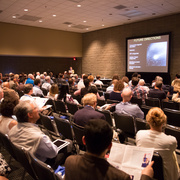
Choose a channel
Check out the different Progress in Mind content channels.

Progress in Mind


Imagine if one working week every month your work performance was limited or compromised. That’s the situation faced by many schizophrenia caregivers who also hold down paid jobs, according to the findings of a large-scale caregiver survey presented by Dr Debra Lerner of the Tufts Medical Center, Boston, at the 2016 APA congress.
Dr Lerner said that over 18% of adults in the US act as unpaid caregivers, and she cited the findings from On Pins and Needles study which showed that three quarters of caregivers looking after someone with mental health issues find the task emotionally stressful.
Many caregivers to people with schizophrenia and schizoaffective disorder work, and Dr Lerner therefore said it was important to try to understand the impact that their caregiving had on work function and productivity. To this end, Dr Lerner got involved in conducting a survey of caregivers who also worked, asking about their paid work commitments and employment.
She described the anonymous on-line survey, which included a number of validated tools such as the work limitations questionnaire (WLQ), designed to assess time lost from work (absenteeism), presenteeism and impact of caregiving on work productivity.
Results from over 1000 caregiver questionnaires were available for analysis, and showed that the average age of caregivers was 55 years, with the average age of the care-recipient 40 years. Most caregivers were women and most were the parent of the person with schizophrenia or schizoaffective disorder.
Over 60% of caregiver respondents were in current work and of those, 69% reported being in full time work. Dr Lerner said that these statistics showing high rates of full time work among carers, emphasized the need to make things easier for caregivers, particularly as the survey showed that most worked outside of the home and many had lengthy commutes to their place of work.
Over a quarter of caregivers in work said they often had to take time off work but more than half said it was difficult to take time away from work for personal matters. Missing an average of 0.6 days per week from work and associated with work productivity losses of around 8%, Dr Lerner said that caregivers had work losses that are equivalent to those experienced by patients with MDD.
The survey highlights that being a caregiver to a person with schizophrenia spills over into work – with a negative impact on productivity. More research is needed to understand and quantify the burdens on those who care for people with serious mental illness.
Hot on the heels of a study showing that at least 8.4 million Americans provide care to an adult with an emotional or mental health issue, comes further information highlighting caregiver burden.



Mood disorders are a leading cause of disability, yet many are highly treatable. To choose the best possible management plan for patients and to plan service provision effectively, it is important to know which patients are at risk of hospitalization and understand the factors that may affect length of stay (LOS) and readmission.
Speaking at an APA session in May 2016, Dr John Goethe of Hartford Hospital in Connecticut, reported the findings of a study of over 12,500 hospitalized patients with mood disorders discharged between 2000 and 2013, which looked at predictors of prolonged LOS and later readmissions. Two thirds of the sample had MDD and readmission was assessed at various time-points after the index admission – 1, 3, 6 and 12 months post-discharge.
A number of potential predictors of long LOS (greater than 9 days) and readmission were examined: presence of psychotic features; being on more than 2 psychotropic drugs; and co-occurrence of other psychiatric conditions, namely bipolar disorder, substance use disorder (drugs and alcohol) and PTSD.
Dr Goethe reported that at the 12-month time-point, 22% of patients with MDD and 24% with bipolar had been readmitted. In terms of LOS for these mood disorders, stays were longer for bipolar disorder than for MDD. He said that having psychotic features with MDD increased the 30-day readmission rate to 11% compared with 7% in patients without psychotic features. Similarly, patients receiving more than 2 drugs for their condition, or having co-occurrent PTSD were more likely to be readmitted at any time during follow-up. In MDD, alcohol use appear to have a protective effect at the 1 month time-point in MDD, reducing readmission rates, but this effect was lost with continued follow-up.
In terms of LOS, psychotic features with MDD and multiple therapies increased LOS, while co-occurrent PTSD reduced LOS.
In the same APA session, delegates heard the findings of two meta-analyses that assessed the types of patients with mood disorders included in randomized, placebo controlled trials (RCTs) in the past 20 years. Professor Mark Zimmerman, Professor of Psychiatry at Brown Medical School, Rhode Island said that a review of antidepressant trials in patients with MDD, which included 170 different studies published in the past 15 years, shows that most of the MDD patients seen in routine practice would be very unlikely to meet the entry criteria. For example, patients with MDD were typically excluded from RCTs for having depression diagnosed for more than 2 years, multiple episodes, for having co-occurrent axis I diagnoses and for suicidality.
According to Professor Zimmerman, this means that at least 40% of the MDD patients seen in routine practice would not be eligible to take part in an RCT of an antidepressant therapy.
The same exercise looking at RCTs in bipolar disorder, also highlighted that patient cohorts are restricted and unrepresentative of real-world patient populations.
Professor Zimmerman conceded that the nature of regulatory studies requires assessment in homogeneous patient populations but he lamented that there is consequently a dearth of real-world data on the effectiveness of treatments in the highly heterogeneous and complex patients actually encountered in everyday practice.
Sign-up for our newsletter and get our APA highlights report.
A highly heterogeneous group of patients come under the umbrella of mood disorders.






